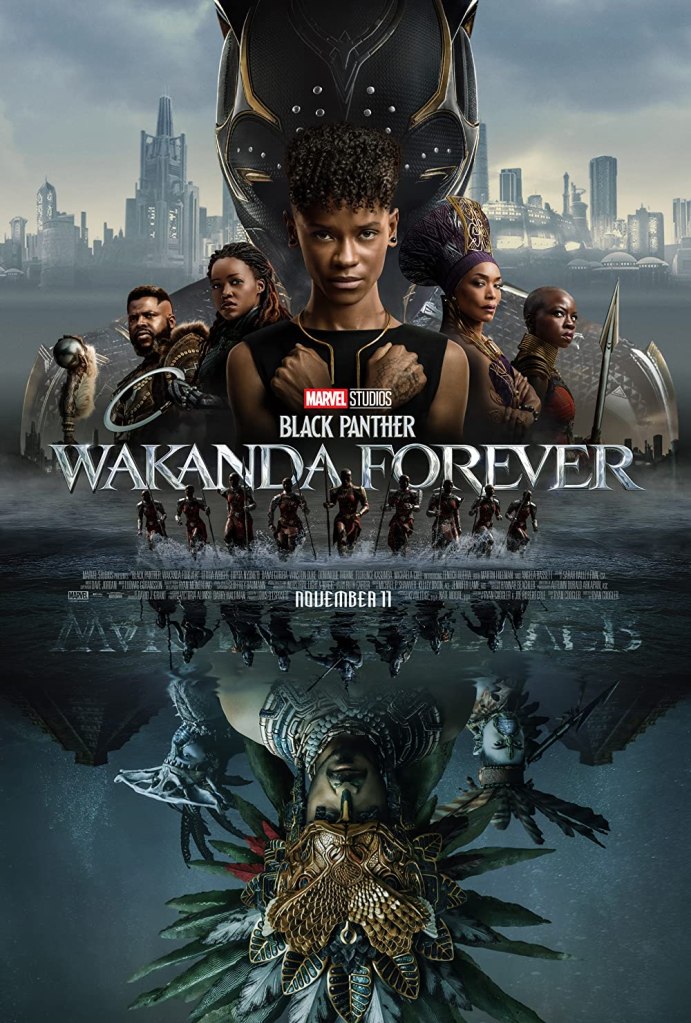I’ll be honest. I thought the first Black Panther was pretty good. Not great. I definitely didn’t feel like it was groundbreaking, outside of it’s presentation of an Afrofuturist world. That was certainly cool. And Chadwick Boseman was great.
Still, I wanted to see Wakanda Forever. I was fascinated by how they would handle T’Challa’s death, how they would integrate Namor, how they would build on everything else that has gone on in the MCU.

So, I liked this one a little bit less. The effects are certainly better. No CGI metal-plated rhinoceroses in this one, at least. The scope of the finale was bigger than the somewhat lackluster fight on a hill with 50 people that ended the first film. But, unfortunately, without Boseman as an anchor, and with some serious story problems, I found the film, in general, kind of a waste of time.
But what did I like? The film looked great. The performances were all great. A lot of the heavy emotional lifting was done by Letitia Wright and Angela Bassett, and they knocked it out of the park. The way practically the entire film is a tribute to Boseman worked. It could have seemed overblown and maudlin. It didn’t.
Now to what I didn’t like, and what generally pushed me out of the film. First, Namor. This character was too much. A four-hundred-year-old mutant who can fly because he has tiny wings on his ankles? No. This doesn’t pass the smell test. I accept the mutation thing, the “I can kind of breath air” thing. I suppose I could accept the “basically immortal” thing, but the ankle-wings killed it for me.
The other thing about Namor that truly grated was that his entire conflict with Wakanda was over Riri Williams, and how she was a threat to Talokan. Um… Namor, did you think Williams was captaining the ship you attacked? Did you think no one else knew how her machine worked? That no one would be able to follow her work? This is, simply, dumb. The vibranium-scanner device is now a thing that people can have. You’ve got to deal with that. You should be working with Wakanda, as your only natural ally, not against them. The writers should have put the Talokan/Wakanda conflict to rest in the first half of the film, and had them both fend off invaders from the outside. That would have made way more sense.
(This is where I put in my standard disclaimer: I never read the comics, and I don’t care if my suggestions contradict those comics.)
Also, side note about Riri. You’re telling me that the US (and probably other world powers) have known about vibranium for nearly 80 years and the only person to figure out how to scan for it is a student who has to hustle jocks for money? And, incidentally, is also the only person (that we know of) to independently develop an Iron Man style flying suit? Yes, Justin Hammer pulled if off after Rhodey stole one, and Ivan Vanko did the same, using blue prints his father provided. Riri Williams made hers from whole cloth… with essentially no money. Don’t. Buy. It.
But perhaps my biggest annoyance with this film is who they chose to put in the Black Panther suit. Shuri is a technician, a scientist. She has shown no evidence of any military training. The heart-shaped herb doesn’t magically grant you fighting skills, a la The Matrix — “I know kung fu.” It’s a level-up on your stamina, endurance, and strength. Steve and Bucky were already soldiers. As was John Walker. Probably Red Guardian, too. We don’t know about the Flag Smashers, but we have no evidence to contradict that they were already trained. Shuri shot her hand cannons at Killmonger a couple of times, and then again in Endgame. Putting her in the Black Panther role is not the best use of Wakanda’s resources. Okoye, Nakia, M’Baku. Any one of them would have been better. I get that it’s comics-accurate. I get that it’s relevant to the emotional journey of the character. And I get that it set up the best cameo in the film (which I will not spoil). But that’s not enough. And it was easy to fix. Maybe Shuri trained in martial arts during the year since T’Challa’s death. Have her family tell her she’s obsessed. Have the elders annoyed with her for abandoning her scientific research. That would make her discovery of how to synthesize the heart-shaped herb that much more exciting and heroic. And less like a necessary story beat because of the title of the movie.
I don’t know if Boseman’s death threw the production into such a state that they couldn’t clean up the story problems and still hit their date, or if this is exactly the film Coogler wanted to make. I just wish it was better.